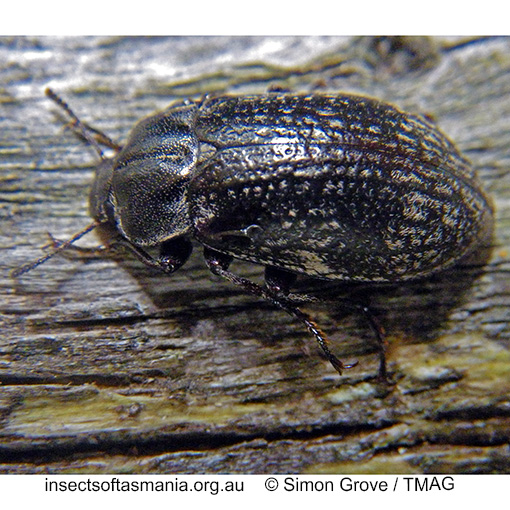
Pachycoelia sulcicollis (a species of darkling-beetle)
Basis for Tasmanian occurrence
Semmens, T.D., McQuillan, P.B. & Hayhurst, G. (1992). Catalogue of the Insects of Tasmania. Government of Tasmania: Department of Primary Industry, 104 pp. (as Lepispilus sulcicollis)
TMAG collections
Classification
Suborder: Polyphaga
Superfamily: Tenebrionoidea
Family: Tenebrionidae
Subfamily: Tenebrioninae
Tribe: Heleini
Morphology
Flightedness: winged and assumed capable of flight
Ecology
Association with dead wood or old trees: obligately saproxylic
Ecological attributes: — Acacia mearnsii is a host-plant (Bashford, 1990a) — Eucalyptus obliqua is a host-plant (Bashford, 1990a) — Pinus radiata is a host-plant (Bashford, 1990a).
Collection method(s) for TMAGmaterial: — At light (with use of light-trap) — Baited trapping (funnel trap) — Beating vegetation (species not specified) — Hand collection (substrate not specified) — Hand collection from Acacia melanoxylon — Hand collection from Eucalyptus amygdalina — Hand collection from Eucalyptus delegatensis — Hand collection from Eucalyptus nitens — Hand collection from Eucalyptus obliqua — Hand collection from Eucalyptus ovata — Hand collection from Eucalyptus regnans — Hand collection from Lomatia sp. — Hand collection from under bark of Eucalyptus obliqua — Not specified — Pipe trapping — Pitfall trapping — Rearing in insectary (host not documented) — Vane trapping.
Source ecological literature:
Bashford, R. (1990a). Tasmanian forest insects and their host plants: records from the Tasmanian Forestry Commission insect collection. Hobart: Tas. Forestry Commission, 32 pages.
Daley, E. (2007). Wings: an introduction to Tasmania’s winged insects. Hobart: 40 Degrees South Pty. Ltd., 236 pages.
Michaels, K.F. (1999a). Carabid beetles as biodiversity and ecological indicators. PhD thesis, Univ. of Tasmania, Hobart.



